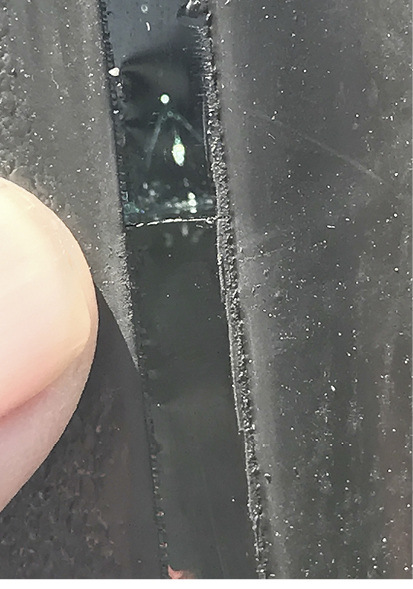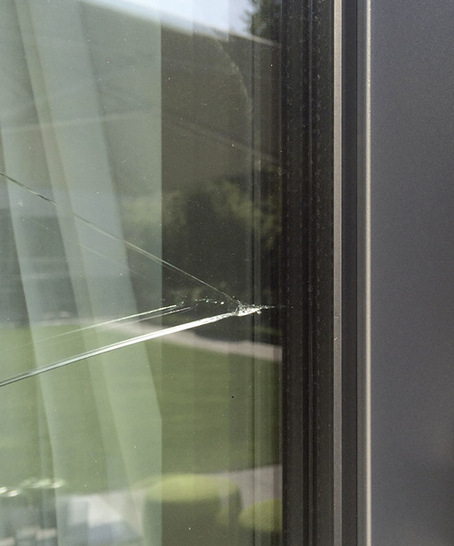A building owner ordered tripple-insulating glass panes from a glass dealer, specifying the essential requirements (alarm of the outer pane, break-in resistance of the inner pane). Only half a year after the glass panes were delivered, a crack was discovered on one of them. The insulating glass pane had to be replaced.
Two and a half years after the first incident, another insulating glass pane showed a crack similar to the first. Since there was now uncertainty as to whether the glass would develop further cracks, the building owner applied to the court for an independent assessment.
The court commissioned a glass expert to settle the following questions:
- Are the cracks due to a technical defect?
- If the window elements are technically defective, what work and costs are necessary to eliminate the defects from a technical point of view? In this case, will the glazing have to be replaced entirely?
The middle float glass pane was affected
In order to assess the facts of the case and to make findings, an on-site inspection was carried out. The insulating glass panes in question were built into window frame elements made of thermally insulated aluminium and have the following structure:
· outer pane: 6 mm ESG with alarm coating, SZR: 14 mm
· middle pane: 6 mm float glass heat-insulated, SZR: 14 mm
· inner pane: Burglar-resistant laminated safety glass made of 2 × 4 mm float glass
The middle float glass pane was cracked. The origin of the crack was located approximately half-way up one of the vertical edges (see above). The crack initially runs horizontally at an angle of 90 degrees from the glass edge and then branches out into the glass surface.
In order to speed up court proceedings, the expert is allowed to submit a settlement proposal to the parties, but since they were unable to agree on a settlement, the court asked the expert to continue the appraisal.
A growing chrack
The crack detected during the first on-site inspection has developed over the past months to such an extent that it became necessary to re-glaze the insulating glass pane. Since inspecting the edge of the glass is essential in order to determine the cause of breakage beyond doubt, the expert used the re-glazing as an opportunity to take a look at the place where the breakage had originated. The crack runs horizontally on the glass edge at an angle of 90 degrees (see here).

Wolf-Dietrich Chmieleck
Was a thermal cracking the cause of the fault?
Put simply, a thermal crack of glass always occurs when the temperature difference between the glass edge that is 'hidden' in the window frame and the visible glass surface exceeds the thermal resistance of the glass pane. This is highly dependent on the nature of the glass edge. For uncoated float glass, this value is about 20 Kelvin – and will be even smalled for float glass with an additional heat protection coating.
See also this article:
Thermal comfort begins with the window
The temperature difference is exceeded when the frame and glass pane cool down overnight and then the visible glass surface heats up quickly in the morning at sunrise, whereas the 'hidden' glass edge remains cooler. Thermally induced glass cracks can be recognised without doubt by their typical pattern:
They first run out from the glass edge at an angle of 90 degrees and then meander into the glass surface. A further characteristic is that the crack on the glass edge also always has an angle of 90 degrees to the outer surfaces. Both characteristics were present in this case.
The conclusion of the glass expert
The thermal glass crack in the middle pane of the insulating glass is due to the fact that it is made of float glass and also coated with a heat protection layer. The coating leads to an increase in the absorption of thermal radiation and the associated heating of the visible surface of the pane. The middle float glass pane of the triple insulating glass should not have been coated. From a technical point of view, the delivered insulating glasses are defective.
The central pane of triple-glazed insulating glass has a particularly difficult time releasing its "accumulated" thermal energy because it is embedded between the outer pane and the inner pane. In the space between the panes, there is no air convection to dissipate the heat. For this reason, there is a particular risk of exceeding the already minimal critical temperature difference between the glass edge and glass surface for thermal cracks.














